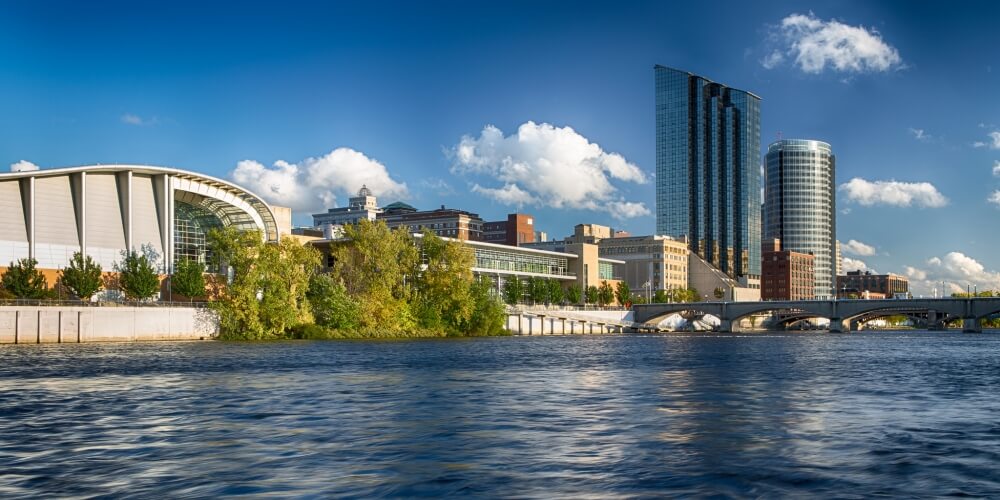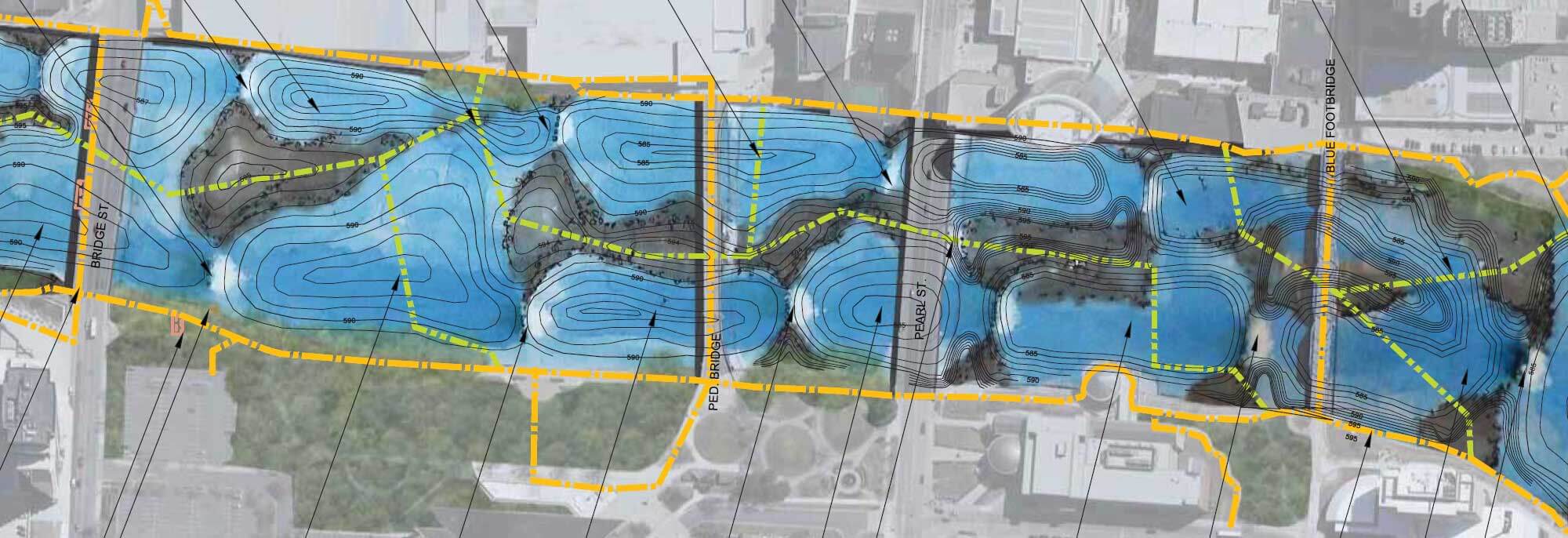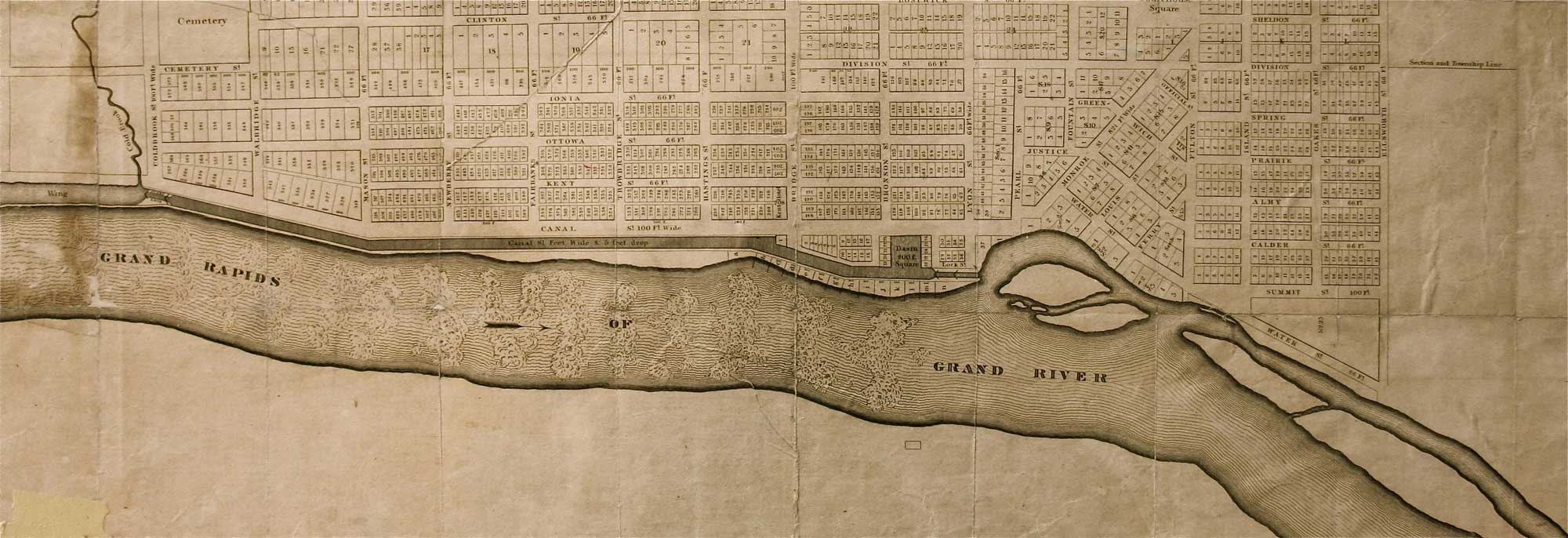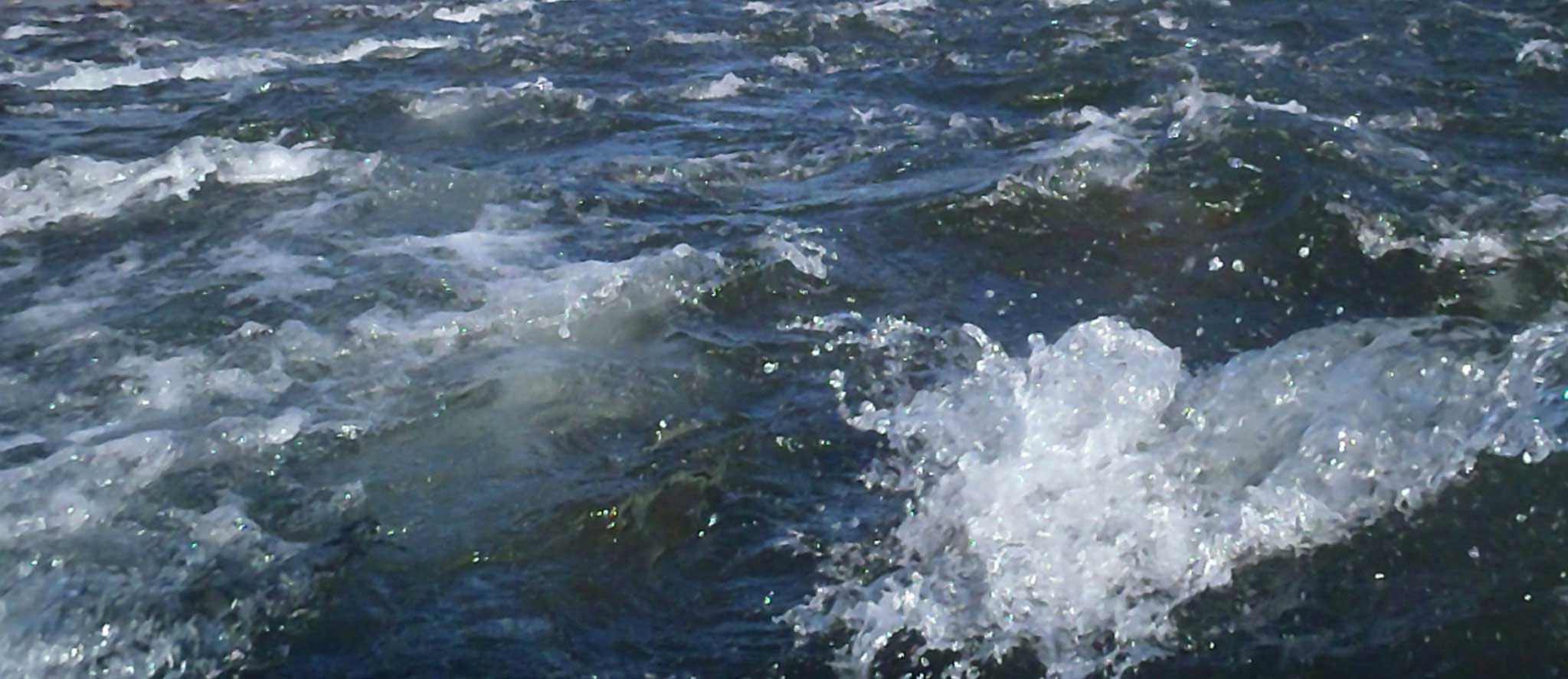Grand Rapids Whitewater has released findings of the Economic Benefits of the Grand Rapids Whitewater Project, a study focused on the potential for expanded economic activity directly related to the restoration of a 2.2-mile stretch of the Grand River through downtown Grand Rapids.
Continue readingGrand Rapids Whitewater Releases Preliminary Plan for River Restoration
Grand Rapids Whitewater is pleased to share this preliminary plan to restore the rapids to the Grand River in downtown Grand Rapids. The plan is based on two years of scientific and engineering studies that evaluated the river bottom, sediment, wildlife and other factors to understand the river. …
Continue readingUrban Waters Federal Partnership adds Legitimacy
At 2:30 p.m. today, federal officials announced that the Grand River is one of 11 locations to be added to the Urban Waters Federal Partnership “to restore waterways, help local economies, create jobs and protect Americans’ health.”
 The event at the Gerald R. Ford Presidential Museum included the chair of the White House Council on Environmental Quality, the acting administrator of the U.S. Environmental Protection Agency, U.S. Sen. Debbie Stabenow and officials from the U.S. departments of Interior and Agriculture.
The event at the Gerald R. Ford Presidential Museum included the chair of the White House Council on Environmental Quality, the acting administrator of the U.S. Environmental Protection Agency, U.S. Sen. Debbie Stabenow and officials from the U.S. departments of Interior and Agriculture.
“It gives us the legitimacy we’ve always needed to move this project along.”
White House Endorses Restoration of Rapids
The U.S. Environmental Protection Agency, in partnership with the White House Council on Environmental Quality, the U.S. Department of Agriculture, and the U.S. Department of the Interior has announced that the Urban Waters Federal Partnership is including the Grand River as one of 11 new locations to restore waterways, help local economies, create jobs and protect Americans’ health.
“The Grand River Urban Waters Federal Partnership is a business and community-led effort to restore an urban river in downtown Grand Rapids, beginning with recreating the namesake rapids.”
– New Life for the Grand River Watershed by the Urban Waters Federal Partnership
Restore the Grand Rapids
Grand Rapids, Michigan. Our city was given its name for a reason, because once, long ago, we actually had natural, free flowing whitewater rapids. There is now an important opportunity before us to restore these namesake rapids to the Grand River for everyone to appreciate and enjoy as the deserved focus of our city.
In 2009, the City of Grand Rapids invited the community to participate in a unique process updating the master plan. This new, innovative approach was named Green Grand Rapids. Citizen participation in Green Grand Rapids was designed to inform policy makers, city staff, nonprofits and various interest groups about those things that are important to citizens. Public input has successfully guided how we can use our infrastructure and what the green priorities should be. This was a ‘grass roots effort’ and from it, Grand Rapids Whitewater emerged as a 501c3 non profit to act as champions for the restoration of our most important natural asset. Overwhelming community support moved the idea to the forefront and in 2012, after a lengthy public process, the city commission adopted the Green Grand Rapids master plan update into the City Master Plan as an amendment. We have before us now, an opportunity to make positive, sustainable social, economic and environmental change.
“We will succeed in making our most important natural feature – the Grand River, increasingly visible and usable by converting older riverfront industrial sites to parks and new development that welcome people to the river’s edge. We will recreate the rapids in the river as a reminder of our heritage.”
– Green Grand Rapids (2012)
As we explore the potential of this proposed legacy project, the community and GRWW seek to remove or modify the dams*, and enhance the channel bed and banks, and to restore the ecological, cultural and recreational functions of the historic rapids. Diversification is the major theme of the Grand Rapids Restoration plan. Diversification of the currents, habitats and recreation use can be achieved through enhancements to the channel bed. The diversified channel will spread out the use, as well as maximize the economic benefits of fishing, whitewater, and aesthetics. Diversification is also the key to stream health as the life cycles of species that evolved with the river can be maximized in a complex and diverse environment.
Goals include;
- Install water quality and habitat enhancements
- Connect historic sturgeon spawning habitat
- Improve access and recreational opportunities for residents and visitors
- Enhance natural aesthetics and riparian function of the riverfront
- Attract tourism, business and employment opportunities
- Create access to natural areas for under represented community members
- Invigorate the cultural significance of the rapids
- Implement a plan a comprehensive plan for watershed and green infrastructure issues
- Generate a stewardship ethic for the river through education and outreach
- As we continue to consult with scientists, watershed experts, engineers and governmental agencies, much is yet to be done.
- Continued public process, community/public involvement assessment
- Additional survey and review of flood impact model
- Fresh water mussel survey
- Baseline condition (P-51 macroinvertebrates, geomorphology) to evaluate impacts of project (biological assessment)
- Finish HEC-RAS modeling
- Dam inspection
- Fish survey
- Detailed hydraulic designs of sea lamprey barrier and USFWS review and comment
- Economic Impact Study
- Hydraulic Ice Analysis
- Climate Change impacts
- Water Quality Monitoring
- Documentation for permit applications
- Baseline Monitoring Surveys
- macroinvertibrates
- substrate (pebble counts, geomorphology survey)
- habitat conditions
Significant restoration of the Grand River in Grand Rapids is achievable. Restoration is expected to have valuable social and economic benefits for the entire community. Further studies will show how the proposed project conforms to major constraints including flood conveyance and sea lamprey control. Restoration of lake sturgeon and fresh water mussel habitats are regionally rare opportunities. Based on concepts, the Grand Rapids Restoration has broad support from the managers and regulators of the river. Compelling community support is being voiced and gaining sustained momentum. A community legacy can be established in restoring the regionally rare functions of the Grand Rapids.
* A new barrier is being studied for implementation upstream as a first line of defense against invasive species and flood conveyance.
Lake Sturgeon are an Awesome Sight
Lake Sturgeon are an awesome sight. They date back to the age of dinosaurs and were once abundant, spawning prolifically in the former rapids of the Grand. The Ottawa know them as Nme’. Lake sturgeon are important spiritually to First Nations people and possess a mystical power in the stories that are shared by generations. They are as important as the eagle and the buffalo.
Life history characteristics of lake sturgeon are unique:
- The typical life-span of lake sturgeon is 55 years for males and 80-150 years for females.
- Spawning occurs on clean, gravel shoals and stream rapids from April to June in preferred water temperatures of 55-64ºf
- Sexual maturity in females is reached between 14 and 33 years, most often from 24-26 years; and, 8 to 12 years for males (but may take up to 22 years)
- Female lake sturgeon spawn once every 4 to 9 years while males spawn every 2 to 7 years;
- Female lake sturgeon lay 4,000 to 7,000 eggs per pound of fish
- Growth rates are quite variable throughout its range and depend on temperature, food availability, and water quality. A male can reach 6 feet and up to 200lbs.
Steelhead Holding Zones
Fish swimming in front of a structure display lower tail-beat amplitudes and body wave speeds, implying that the bow wake may be the most energetically favorable region for a fish to hold position near a large rock.
A sandy bottom, like the one in the first diagram, causes very little disturbance to the flow of water and has a very shallow zone above it. Steelhead will move over an area like this, but there is no incentive for them to hold here for an extended period of time, since they would have to exert energy to stay here.

A bottom made up of rocks, however, creates more disturbance in the water and results in a much wider zone of reduced current along the bottom. The bigger the rocks, the deeper this area of turbulence will be along the river bottom.

https://www.youtube.com/watch?v=d68FXr9oF-Y
Michigan Department of Natural Resources Support
“Michigan Department of Natural Resources Director Keith Creagh says political and funding support is there for Grand Rapids Whitewater”
Read more in the Grand Rapids Press article State support and funding is available for Grand Rapids Whitewater project, says DNR chief.
DNR head approves of plan to restore the rapids
“There’s one challenge about putting the rapids back into Grand Rapids, and that’s making sure that sea lampreys don’t continue up the Grand River. So they’ll go through a series of boulders and structures, and they’ll still have a lamprey control structure throughout the project. But it should increase the fisheries,” said Creagh.
WZZM 13 reports that the DNR head approves of plan to restore the rapids.






